#greater one horn rhino
Text




SHOP UPDATE!!!
I’ve added a few more stickers to my Etsy shop!! We’ve got The Horrors Persist Frostpaw, NO GO BACK Tiktaalik, a Sleeping Rhino in a Mud Puddle, and a Playful Elephant Calf!!! I really love all of these ones, go check em out if you get a chance!!!! <33
#the rhino and elephant ones were based on some animals I worked with over the summer!!#and ofc Tiktaalik is my favorite fishapod so it absolutely needed a sticker#and I couldn’t resist making Frostpaw lmao#Jomadis#Etsy#art#my art#warrior cats#warriors#cat#wc#asc#a starless clan#fan art#Tiktaalik#elephant#Asian elephant#greater one horn rhino#rhino#paleontology#zoology#evolution#science memes#fossil#pachyderm#even tho that ones outdated#small business#etsyseller#stickers
67 notes
·
View notes
Text
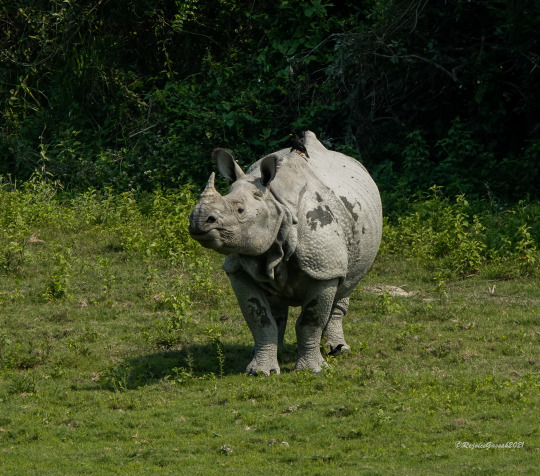
Meet the greater one-horned rhino (Rhinoceros unicornis). This mighty mammal can weigh as much as 6,000 lbs (2,721 kg)! It’s distinguished by its single horn, which can reach lengths of 25 in (63 cm). Despite its size, this herbivore can move quickly, charging at speeds of up to 25 mph (40 km/h). This semi-aquatic animal prefers to live near water and tends to inhabit swamps, riversides, and forests in parts of Asia, including Nepal and India.
Photo: rejoicegassah, CC BY 4.0, iNaturalist
#nature#animals#rhino#did you know#fact of the day#greater one horned rhino#cool animals#animal kingdom#mammals
475 notes
·
View notes
Text
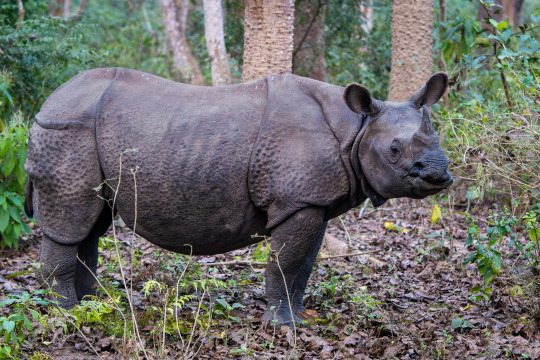
Greater one-horned rhinoceros Rhinoceros unicornis
Observed by shanes, CC BY-NC
19 notes
·
View notes
Text

Greater One-Horned Rhino (Rhinoceros unicornis)
taken at the Denver Zoo in Denver, Colorado
status: vulnerable
These big animals are also known as the Indian Rhino but an easy way to identify them is by their single horn that can grow to be 8 to 25 inches in length!
#Greater One-Horned Rhino#Greater One Horned Rhino#Indian Rhino#Rhinoceros unicornis#animal#wildlife#denver zoo#denver#zoo#colorado#photo#photography#canon#canon 6d mark ii
11 notes
·
View notes
Text
I Am Blackened Bones (Part 3)
Approximately 4 tons.
20 to 55 inches for the horn.
And the average height still eludes her.
As her memory rots so do the details. There are several species of komodo rhino, each has their own statistics. 4 tons and 20 to 55 inches for the horn; this could be either the black or the white komodo rhino. She should know which. She used to. Whichever one it is not is the species that gets to be nearly 7 tons and has a horn length up to 59 inches. And then there are the greater one horns and the Caldera ash komodo rhinos. The greater one horned variety can weigh a formidable 7 tons at most with a horn length of 39 inches.
The Caldera ash komodo rhinos have always been her favorite. They are the largest, the strongest. They are on average 10,000 pounds of fury and brute with horns that can exceed 60 inches. They like to linger around active volcanoes. She remembers the myth: that their hide is thick enough to withstand lava.
But Azula cannot remember any of the heights.
20 to 55 inches. 4 tons. Black or white komodo rhino. 59 inches. 7 tons. White or black komodo rhino. 39 inches. 7 tons. Greater one horned komodo rhino. 60 inches. 10,000 pounds. Caldera ash komodo rhino.
She clings to these facts. Repeats them over and over again so not to lose them. Should she come by one of them on her misadventures she could feed the black komodo rhino twigs and shoots, the white komodo rhino favors a similar diet but it would require much more. And so she decides that it must be the white komodo rhino that is 7 tons with 59 inch horns. But she could have that wrong too. She could have the diets mixed up.
She claws at what would be her hairline were she not wearing a crown of flame. The greater one horned komodo rhinos prefer a diet of aquatic plants while the Caldera ash favor meat—both small and large game. They can eat over a hundred pounds a day if they so choose.
It is how the grow to be the size that she cannot recall.
20 to 55 inches, 4 tons black komodo rhino. 59 inches…
She cannot let herself forget because it is nearly all that she has left as far as the komodo rhinos are concerned. She can remember her stuffed toy and that it had a name. But what was it? She remembers that the toy had armor but she can’t remember who gave it to her. Father? Mother? Zuzu? No, Zuzu was too young. So Iroh or Lu Ten? Grandfather?
She grits her teeth. She knows this. She does!
And where had she gotten the toy? She knows that father had given it to her, but she can’t remember where or when. Or why.
And so she recants the numbers 20 to 55 inches, 4 tons…
Numbers always have been easier for her to remember than emotions and aromas.
Numbers have sense to them. Order. Emotions are chaos, they don’t quite follow any rules. Nothing really follows rules anymore. Nothing has consistency. Rhythms and patterns are becoming scarce.
The pain doesn’t help. Sometimes it gets to be so overwhelming that she can’t even muster up her possibly botched numbers. Sometimes, she has to stop in the middle of her mantra to wait out the pain. Most of the time it passes. Sometimes it takes an exceptionally long time, long enough that Azula begins to fear that it will never subside.
Today, she isn’t hurting. Not quite as badly. So she lets her mind wander a bit. She has a childhood memory, but the details are fuzzy. She is on some beach somewhere. It is sunny. Zuzu is smiling and laughing and she is too. They had just emerged from the water and they had sworn that they’d seen a lionturtle. Mother had humored them. Father had rolled his eyes but he didn’t protest their fantasies.
Azula misses father. She sort of misses Zuzu too. She even misses mother and maybe Iroh. She misses a life that she never had. A life that she could have had. She misses all of the choices that she had never gotten. Or maybe she had gotten them, just the same as Zuzu had, and she had just scoffed at them and tossed them aside. And for it, she wears fire on her body.
At last it makes sense.
Something makes sense.
She has only ever had her firebending.
It was all that really mattered to her; firebending and the glory, admiration, and affection that it brought her.
And now fire is all that she will ever be.
She has a crackling laugh. She hates the sound of it. But she can’t stop. Because it is so funny. So dreadfully hilarious. The poetry, the symmetry. It is satisfying in some sick and dark sense. And so she laughs her crackling laugh and the fire erupts from her throat. Sprays sparks into the night sky.
Weather she realized it or not, Azula’s firebending had always been her undoing.
And it undoes her still.
11 notes
·
View notes
Note
we HAVE unicorns, they're all different levels of engagement

which unicorn is your favorite?
How quickly I forget the humble unicorn...
Gotta go with the greater one-horn rhino/Indian rhino (it's even called Rhinoceros unicornis) I like their ear shape, and I like when a mammal is semi-aquatic.

silly guy
#fortunately the Indian rhino isn't endangered#also that pic of the Sumatran rhinoceros has the brush in front of it- I thought the poor thing just had a dip#like a cartoon character getting squished in one part of their body#personal pig#chimeramoth
9 notes
·
View notes
Photo

No rhinos were poached last year in the world's largest reserve for the endangered great one-horned rhinoceros, India's Assam state, in what authorities said was the first time since 1977.
Poachers killed more than 190 rhinos in Assam between 2000 and 2021 but none was killed last year, according to data shared by the Assam Police. According to IFAW, the greater one-horned rhino, also known as the Indian rhino, were once widespread across the entire northern region of India until they were decimated in the early 19th century due to the popularity of sport hunting. As a result, it is estimated that in 1908 there were only 12 rhinos left in Kaziranga, India. Thankfully, Assam, is now home to the world’s largest population of greater one-horned rhinos, with nearly 2,900 across the region today. Thanks to conservation efforts, the species has now doubled across north-eastern India. Source: World Animal News (link in bio)
#conservation #rhino #india https://www.instagram.com/p/CoH6aYer6n2/?igshid=NGJjMDIxMWI=
77 notes
·
View notes
Text
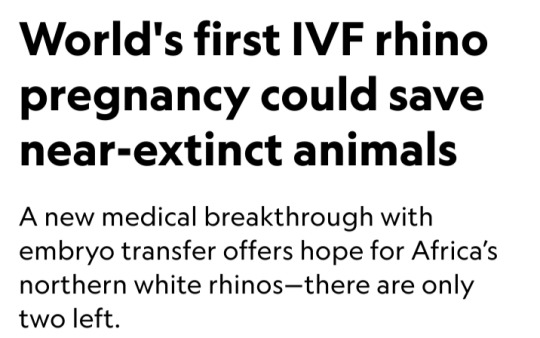

By Dina Fine Maron
January 24, 2024
Scientists have cleared a significant hurdle in the years-long effort to save Africa’s northern white rhinoceros from extinction with the first-ever rhino pregnancy using in vitro fertilization.
The lab-assisted pregnancy, which researchers will announce today, involved implanting a southern white rhino embryo in a surrogate mother named Curra.
The advance provides the essential “proof of concept” that this strategy could help other rhinos, says Jan Stejskal of the BioRescue project, the international group of scientists leading this research.
Curra died just a couple months into her 16-month pregnancy from an unrelated bacterial infection, Stejskal says.
However, the successful embryo transfer and early stages of pregnancy pave the way for next applying the technique to the critically endangered northern white rhino.
The process was documented exclusively by National Geographic for an upcoming Explorer special currently slated to air in 2025 on Nat Geo and Disney+.
BioRescue expects to soon implant a northern white rhino embryo into a southern white rhino surrogate mother.
The two subspecies are similar enough, according to the researchers, that the embryo will be likely to develop.
Eventually, this approach may also help other critically endangered rhinos, including the Asian Javan rhinoceros and the Sumatran rhinoceros, which each now number under 100 individuals, Stejskal says.
But the northern white rhino’s current situation is the most pressing by far.
There are no males left, and the only two remaining animals are both elderly females that live under armed guard on a reserve in a 700-acre enclosure in Kenya called Ol Pejeta Conservancy.
The boxy-jawed animals once roamed across central Africa, but in recent decades, their numbers have plummeted due to the overwhelming international demand for their horn, a substance used for unproved medicinal applications and carvings.
Made from the same substance as fingernails, rhino horn is in demand from all species, yet the northern white rhino has been particularly hard-hit.
"These rhinos look prehistoric, and they had survived for millions of years, but they couldn’t survive us,” says Ami Vitale, a National Geographic Explorer and photographer who has been documenting scientists’ efforts to help the animals since 2009.
“If there is some hope of recovery within the northern white rhino gene pool — even though it’s a substantially smaller sample of what there was — we haven’t lost them,” says conservation ecologist David Balfour, who chairs the International Union for the Conservation of Nature’s African rhino specialist group.
Blueprints for rhino babies
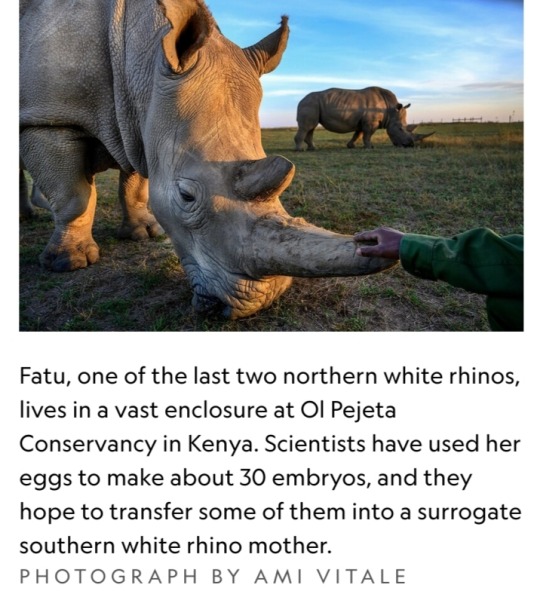
To stave off the animal’s disappearance, BioRescue has used preserved sperm from northern white rhinos and eggs removed from the younger of the two remaining females.
So far, they’ve created about 30 preserved embryos, says Thomas Hildebrandt, the head scientist of BioRescue and an expert in wildlife reproduction based at the Leibniz-Institute of Zoo and Wildlife Research in Berlin.
Eventually, the team plans to reintroduce northern white rhinos into the wild within their range countries.
“That’d be fantastic, but really, really far from now—decades from now,” says Stejskal.
Worldwide, there are five species of rhinoceros, and many are in trouble.
Across all of Africa, there are now only about 23,000 of the animals, and almost 17,000 of them are southern whites.
Then there are more than 6,000 black rhinos, which are slightly smaller animals whose three subspecies are critically endangered.
In Asia, beyond the critically endangered Javan and Sumatran rhinos, there’s also the greater one-horned rhino, whose numbers are increasing and currently are estimated to be around 2,000.
The BioRescue effort has experienced many setbacks, and even though the team now has frozen embryos, the clock is ticking.
The researchers intend to use southern white rhinos as surrogate moms for the northern white rhino embryos.
However, scientists want any northern white rhino calves to meet and learn from others of their kind, which means they need to be born before the two remaining females die.
“These animals learn behaviors — they don’t have them genetically hard-wired,” says Balfour, who’s not involved with the BioRescue work.
But birthing new animals in time will be a challenge.
“We’re really skating on the edge of what’s possible,” he says, “but it’s worth trying.”
Najin, the older female, will be 35 this year, and Fatu will be 24.
The animals, which were born in a zoo in the Czech Republic, are expected to live to about 40, says Stejskal, who also serves as director of international projects at the Safari Park Dvůr Králové, the zoo where the animals lived until they were brought to Kenya in 2009.
Impregnating a rhino
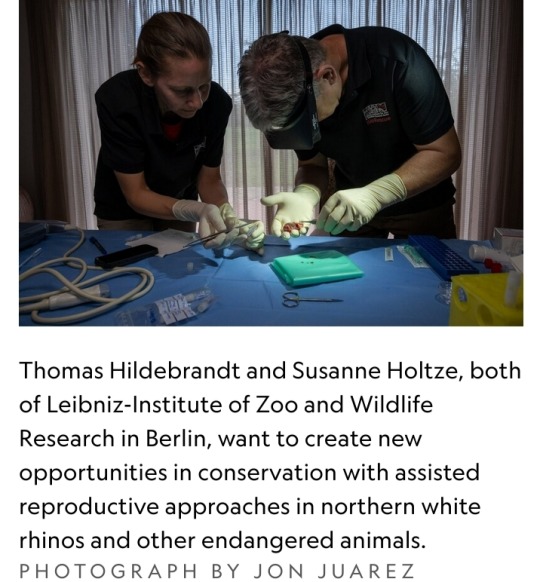
The next phase of BioRescue’s plan involves implanting one of their limited number of northern white rhino embryos into a southern white rhino surrogate mother — which the group plans to do within the next six months, Stejskal says.
They’ve identified the next surrogate mother and set up precautions to protect her from bacterial infections, including a new enclosure and protocols about disinfecting workers’ boots.
But now, they must wait until the female rhino is in estrus — the period when the animal is ready to mate — to implant the egg.
To identify that prime fertile time, they can’t readily perform regular ultrasounds at the conservancy as they might do in a zoo.
Instead, they have enlisted a rhino bull that has been sterilized to act as a “teaser” for the female, Hildebrandt says, adding that they must wait a few months to make sure that their recently sterilized male is truly free of residual sperm.
Once the animals are brought together, their couplings will alert conservancy staff that the timing is right for reproductive success.
The sex act is also important because it sets off an essential chain of events in the female’s body that boosts the chances of success when they surgically implant the embryo about a week later.
"There’s little chance the conservancy staff will miss the act. White rhinos typically mate for 90 minutes," Hildebrandt says.
What’s more, while mounted on the females, the males often use their temporary height to reach tasty plant snacks that are generally out of reach.
Boosting genetic diversity
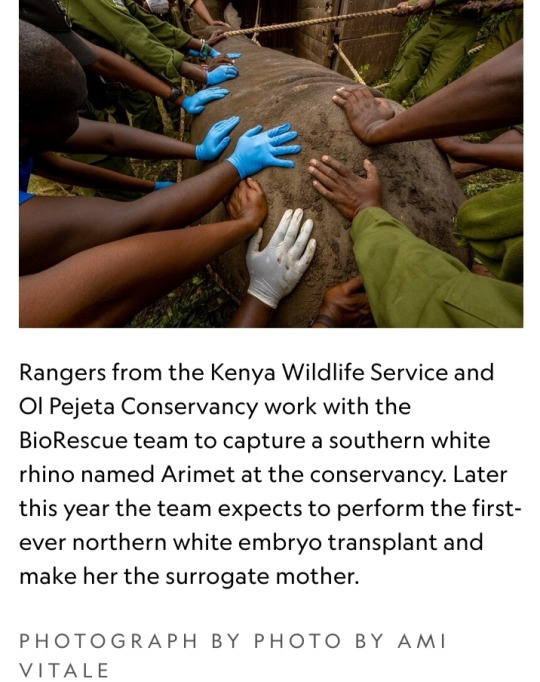
With so few northern white rhinos left, their genetic viability may seem uncertain.
But the BioRescue team points to southern white rhinos, whose numbers likely dropped to less than 100, and perhaps even as few as 20, due to hunting in the late 1800s.
Government protections and intense conservation strategies allowed them to bounce back, and now there are almost 17,000.
“They have sufficient diversity to cope with a wide range of conditions,” says Balfour.
Researchers don’t know exactly how many southern white rhinos existed a century ago, he says, but it’s clear that the animals came back from an incredibly low population count and that they now appear healthy.
Beyond their small collection of embryos, the BioRescue team hopes to expand the northern white rhino’s gene pool by drawing from an unconventional source — skin cells extracted from preserved tissue samples that are currently stored at zoos.
They aim to use stem cell techniques to reengineer those cells and develop them into sex cells, building off similar work in lab mice.
According to their plan, those lab-engineered sex cells would then be combined with natural sperm and eggs to make embryos, and from there, the embryos would be implanted into southern white rhino surrogate mothers.
Such stem cell reprogramming work has previously led to healthy offspring in lab mice, Hildebrandt says, but rhinos aren’t as well-studied and understood as mice, making this work significantly challenging.
A global effort
The northern white rhino revitalization venture has cost millions of dollars, supported by a range of public and private donors, including the German Federal Ministry of Education and Research.
Other partners on the effort include the Leibniz Institute for Zoo and Wildlife Research, the Czech Republic’s Safari Park, Kenya Wildlife Service, Ol Pejeta Conservancy, and also Katsuhiko Hayashi, a professor of genome biology at Osaka University in Japan who conducted the mouse stem cell research.
Building upon Hayashi’s stem cell techniques could ultimately bring the northern white rhino gene pool up to 12 animals — including eggs from eight females and the semen of four bulls, according to Stejskal.
An alternative approach to making more babies, like crossbreeding northern and southern white rhinos, would mean the resulting calves wouldn’t be genetically pure northern white rhinos, Hildebrandt notes.
The two subspecies look quite similar, but the northern version has subtle physical differences, including hairier ears and feet that are better suited to its swampy habitat.
The two animals also have different genes that may provide disease resiliency or other benefits, Hildebrandt says.
There are unknown potential differences in behavior and ecological impact when populating the area with southern white rhinos or cross-bred animals.
"The northern white rhino is on the brink of extinction really only due to human greed,” Stejskal says.
“We are in a situation where saving them is at our fingertips, so I think we have a responsibility to try.”
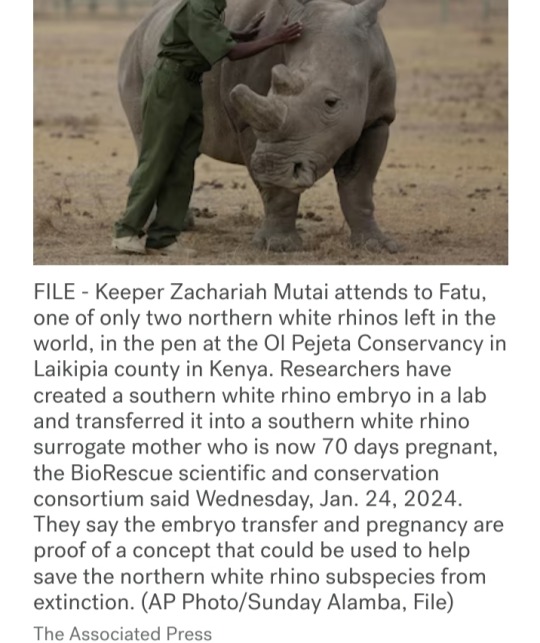
🩶🦏🩶
#northern white rhinoceros#rhino embryo transfer#in vitro fertilization#IVF#southern white rhinoceros#critically endangered animals#National Geographic#BioRescue#rhino horn#International Union for the Conservation of Nature#African rhino specialist group#Thomas Hildebrandt#German Federal Ministry of Education and Research#Leibniz Institute for Zoo and Wildlife Research#Kenya Wildlife Service#Ol Pejeta Conservancy#Katsuhiko Hayashi#genome biology#IVF rhino pregnancy
8 notes
·
View notes
Photo

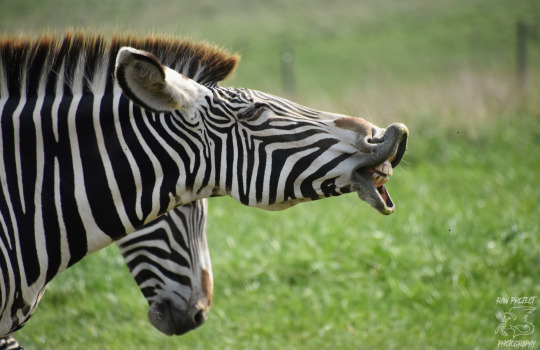
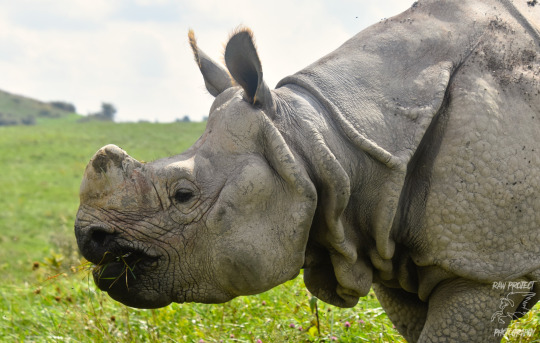
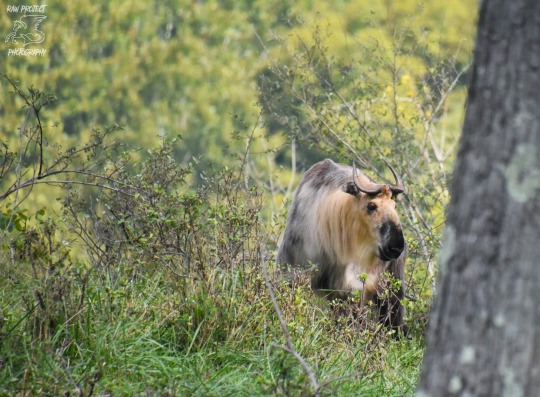
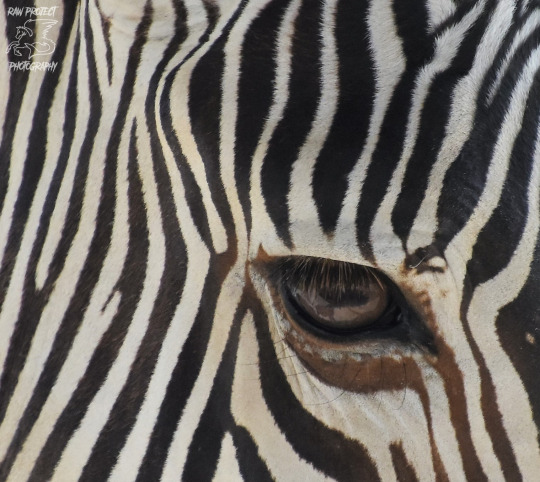
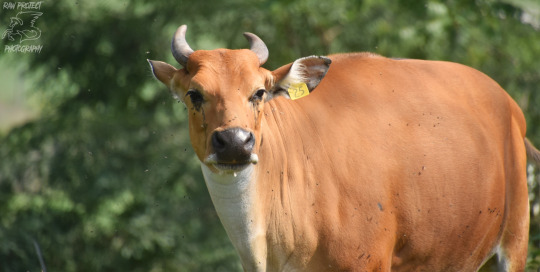
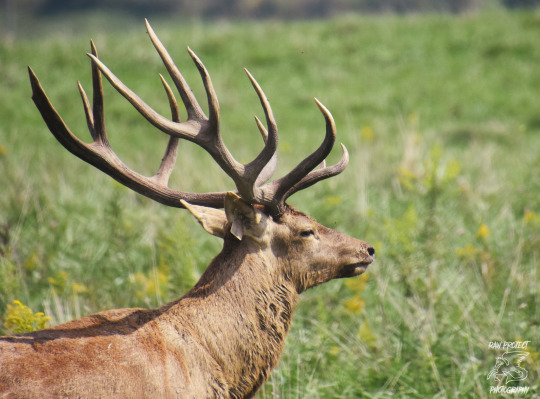


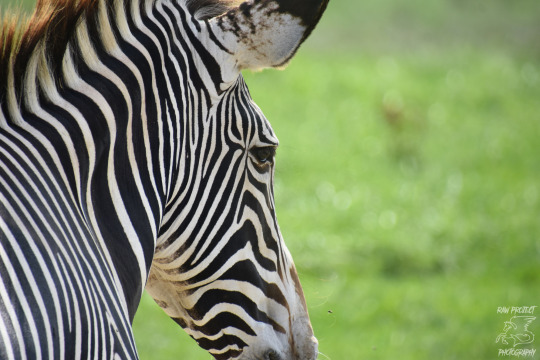
A few shots from the really neat bus safari I did at The Wilds! The Wilds is North America’s largest conversation facility located north of Columbus, in association with the Columbus zoo. Here we have a Greater One-Horned Rhino bull, the Grevy’s Zebra herd, a lovely Pere David’s stag, the Sichuan Takin, and a female Banteng. The banteng is the pretty sorrel cow, and the takin is the cute guinea-pig deer with wildebeest horns.
Photography © Me
It is unlawful to remove photography watermarks
Do not remove caption
Thank you!
33 notes
·
View notes
Text

Ashmi does not tolerate poaching in her neck of the jungle. Asian elephants (and particularly forest elephants), as well as greater one horned rhinos are particularly at risk for the ivory trade. In addition, the bengal tigers whose territories outskirt her own are also very vulnerable, as well as sloth bears whose body parts make up traditional medicine.
Ashmi may forgive tresspassers more these days, but this is an unforgivable offense, and the price to pay is with your life.
5 notes
·
View notes
Text

I have recently fallen victim to loving the Greater One-Horn Rhino, their puppy stare is just lethal
Some more practice pieces; I want to eventually make a bigger piece for my mentors before my internship is over!! ;w;
#their heads are like really weird horses#and their slobber is something special#gotta love rhinos#jomadis#art#my art#traditional#animal#animals#nature art#animal art#sketch#rhino#greater one horn rhino#zoo#zoology#Indian rhino
86 notes
·
View notes
Photo

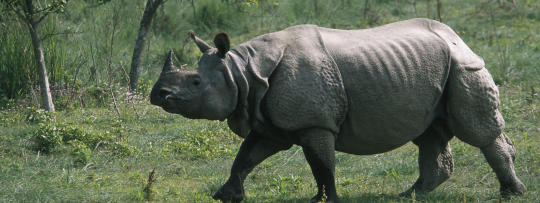
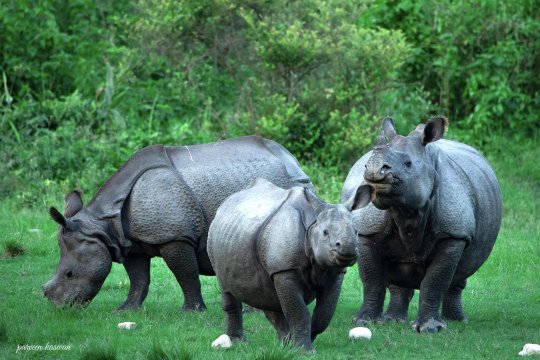
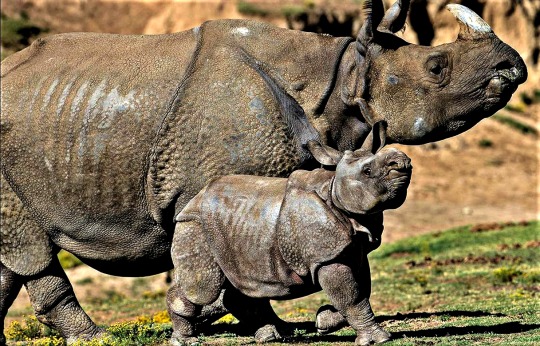
The Indian rhinoceros, also called the Indian rhino, greater one-horned rhinoceros or great Indian rhinoceros, is a rhinoceros species native to the Indian subcontinent where they can be found in a handful of national parks throughout the countries of India and Nepal. The Indian rhino alongside its close relative the Javan rhino make up the genus rhinoceros. Unlike most other species of modern rhino which are typically solitary animals, the Indian rhino can often be found living in social groups of upwards of 6 individuals typically consisting of mothers and there calves as well as subadults, said groups are occasionally accompanied by a bull but as they grow older males grow more solitary in nature. They typically inhabit grasslands, open dry forest, and riverine woodlands where they feed upon grasses, roots, leaves, branches, fruits, and submerged and floating aquatic plants. Because of there size indian rhinos have few natural predators except for tigers and mugger crocodiles which occasionally prey upon young, elderly, or infirm rhinos. Males are typically larger than females standing at upwards of 6ft tall at the shoulder, 12ft in length, and 4,800lbs in weight compared to females at 5ft tall at the shoulder, 11ft in length, and 3,500lbs in weight. This makes the Indian rhino the second largest living rhino species behind the white rhino, and also the second largest land animal in asian behind the asian elephant. These rhinos have a thick grey-brown skin with pinkish skin folds and one horn on their snout. Their upper legs and shoulders are covered in wart-like bumps. They have very little body hair, aside from eyelashes, ear fringes and tail brush. Adult males sport huge armored neck folds. After a 15-16 month pregnancy mother Indian rhinos will typically give birth to a single calf, which will remain by there mothers side for at least 2 years. Females reach sexual maturity sooner than males at around 4 years compared to males a 5 years of age. Under ideal conditions an Indian rhino may live upwards of 40 years.
#pleistocene#extant#living#indian#rhino#rhinoceros#mammal#one#horned#unicorn#horn#great#pleistocene pride
5 notes
·
View notes
Text

Greater one-horned rhinoceros Rhinoceros unicornis
Observed by adamfromcanada, CC BY-NC
22 notes
·
View notes
Text

Greater One-Horned Rhino (Rhinoceros unicornis)
taken at the Denver Zoo in Denver, Colorado
status: vulnerable
At the beginning of the 20th century there were only 200 of these wild animals left. Through conservation they were able to bring their numbers up to around 3700 today!
#Greater One-Horned Rhino#Greater One Horned Rhino#Indian Rhino#rhinoceros#Rhinoceros unicornis#denver zoo#denver#zoo#colorado#photo#photography#canon#canon 6d mark ii
3 notes
·
View notes
Text
Indian #Rhinoceros are in trouble in #India their range in #Assam is earmarked for #palmoil #deforestation. Fight for them in the supermarket and #Boycottpalmoil #Boycott4Wildlife via @palmoildetect
#palm oil#rhinoceros#india#assam#deforestation#boycottpalmoil#boycott4wildlife#animalrights#161#1312#econotego#ecology#ausgov#politas#auspol#tasgov#taspol#australia#fuck neoliberals#neoliberal capitalism#anthony albanese#albanese government#class war#animals#animal#environmental activism#environmental#environment#enviroment art#environmetalists
1 note
·
View note
Photo
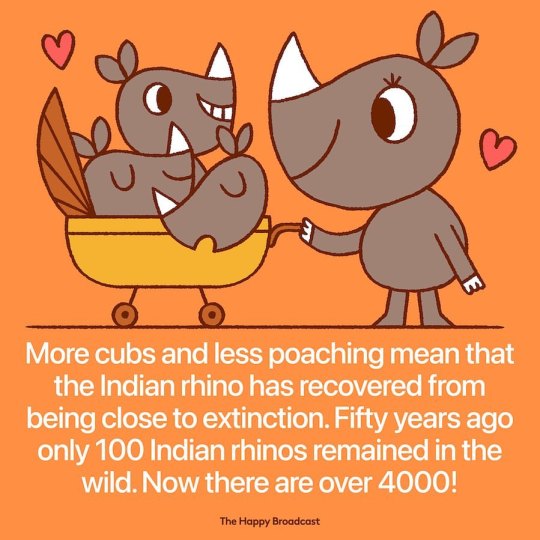
🦏 ❤️ Today we’re celebrating a HUGE milestone for the greater one-horned rhino – the species’ population now numbers 4,014 individuals! The government of Assam, the province in India that is home to 70% of the world’s greater one-horned rhino population, just completed its biannual rhino census. The greater one-horned population has increased by 274 rhinos since the last count – helped by a baby boom during the pandemic when many protected areas were closed to visitors. For a species that was once perilously close to extinction, numbering fewer than 100 individuals, this recovery is truly remarkable. The greater one-horned rhino population is growing because the governments of India and Nepal have given rhinos the space they need to breed while also preventing poaching deaths. Last year, only 1 rhino was poached in the state of Assam – the lowest rate in over two decades! Source: Rhinos.org (link in bio) #rhino #conservation #success #onehornedrhino https://www.instagram.com/p/Ce6GkExraoc/?igshid=NGJjMDIxMWI=
73 notes
·
View notes